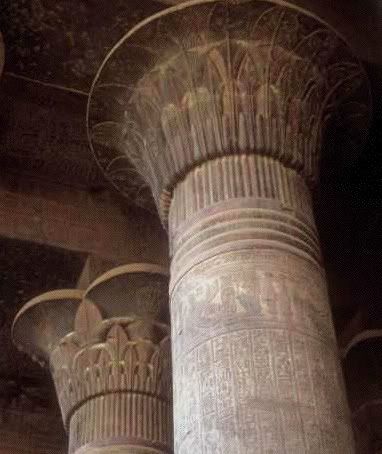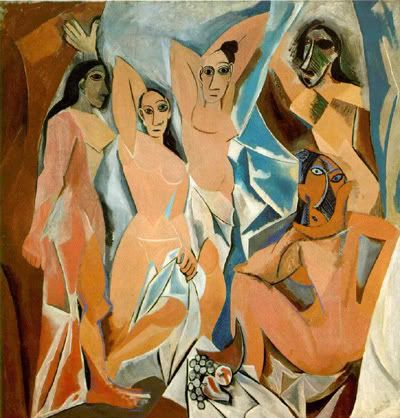Eye of the Beholder?
It may now be said that an object becomes, or fails to become, a work of art in direct response to the inclination of the perceiver to assume an appreciative role.
--Victor Burgin, "Situational Aesthetics"
Who among us hasn't wondered why fractal art cannot seem to crack the glass ceiling of broader cultural recognition and gain entry into the pantheon of the larger art world?
Could it be that we are up to the challenge of processing our art, both aesthetically and technologically, but those who view fractal art are not yet up to the task of processing it psychologically?
Cynthia Ward, writing in Politics and Culture, says in "African Visual Culture: Minding an F":
Since the founding of fractal geometry by Benoit Mandelbrot twenty-five years ago, there has been a growing iterative feedback loop of fractal art analysis, ranging from Hugh Kenner's 1988 study of Ezra Pound's Cantos to recent analyses of the fractal dimensions of Pablo Picasso's Les Demoiselles d'Avignon and Jackson Pollock's drip paintings. Many of these analyses suggest directly or indirectly that the appeal of fractal art arises from an innate response to fractals, which have been called "the basic building blocks of nature's scenery" and even "the fingerprints of God" ([Richard] Taylor, "Fractal Expressionism"). [Physicist Richard] Taylor has extensively analyzed the fractal dimension of Pollock paintings in such publications as Nature, Leonardo, and Scientific American and he, as well as other researchers, have attempted to determine the fractal dimension or "D value" considered "most pleasing" to viewers.
Les Demoiselles d'Avignon (1907) by Pablo Picasso
It probably won't surprise you that fractal forms scored in the two lowest registers of sensory pleasantry. The "wow" factor is strong, but, apparently, fractal shapes are not comfort food for the raised-on-representational-art masses. Even worse, Taylor argues that people cannot easily reboot what art they like because preferences are "set...by continuous visual exposure to patterns characterized by this D value."
Ward feels this internalized aesthetic selection process explains the chorus of critical whack-a-mole reactions to fractal art. What's worse is that individualized sensory biases will not easily shift overnight. Ward feels history supports her:
There is strong evidence that fractal appreciation is not innate or instinctive. The initial reception of artworks now considered fractal was characterized by shock, horror, hostility, and derision. In 1956 Time magazine labeled Pollock "Jack the Dripper." Early viewers of Les Demoiselles d'Avignon were appalled by the "hideousness of the faces" of the "monstrous" women in the "terrible picture," which Picasso did not exhibit until nine years after completion, when reviewers called it a "nightmare" (qtd. in Arthur Miller, Einstein, Picasso: Space, Time, and the Beauty That Causes Havoc). In The Fractal Geometry of Nature, Mandelbrot stresses the predominance of negative aesthetic assessments of fractal shapes as "'monstrous,' 'pathological,' or even 'psychopathic'" --an attitude reflected in a long history of western mistrust of concepts central to fractals such as irrational numbers and infinity. As Ron Eglash observes [in African Fractals: Modern Computing and Indigenous Design], in "Plato's philosophic cosmology, spiritual perfection was seen as the higher level of transcendent stasis, and illusion and ignorance were the result of life in our lower realm of changing dynamics ('flux,' which in ancient Greek also means 'diarrhea')."
Well, no wonder people sometimes tell me my work looks like...
~/~
So, fractals iterate chaos rather than serenity in many people's brains. Ward goes on to explain in significant detail that the numerous fractal objects found in early African art worked heavily against its canonical acceptance. Gallery patrons, wanting comfortable shapes and satisfied minds, opted instead for more calming representational forms. You know the drill: faces in portraiture, bowls of fruit, saints in repose or martyrdom.
Even a quick surfing excursion shows that Ward is correct on one front. Fractals pop up all over African art:

Tuareg leatherwork: the basic shape is made of 6 copies each shrunk by

Ancient Egyptian cosmology often used the lotus blossom as an image for the development of the universe.
The petals within petals within petals of the lotus represented the cosmos on smaller and smaller scales.
[Both images seen on African Fractal Art]





8 Comments:
This, with Ward's paper, blows me away.
Fractal art often has a face that only its creators love. This may explain why.
I have found myself creating images that look like something real, like flowers, spheres and birds. I wonder if I do that because I am uncomfortable with fractal art
8/10/2006 2:51 PM
I think your basic premise, Terry -- that the problem is not with the art but in its perception -- applies to every work in every form of art created since the dawn of man. It happens not only in every medium of visual art, but in writing, theatre, music, dance, etc. No work appeals to or is embraced by everyone and, as my father used to say, "There's no accounting for some people's tastes!"
Like Mindy, I've experienced lots of enthusiasm for fractals -- at least for my own work, which is where I have the most personal experience with perception. I create abstract works because that is the style of art I love, have always loved -- even before I knew anything about fractals. Those with similar tastes like my work. Those who don't walk on by (or don't bother to email).
Keith wonders if he creates more representational work because he is more comfortable with it than more abstract pieces. (I'm rephrasing your words, Keith, so please correct me if I mis-represented your thoughts.) There's nothing wrong with that. I think each of us creates the kind of art we enjoy. And we all meet with relative success based on whether the work is seen by those with like interests and tastes.
I think Kerry has a great attitude in his joy of apathy. I also try to create the art I love to create because it brings me joy. When I let any other reasons eclipse that motive -- desire for acceptance, acclaim, sales, fame, fortune... -- I find I tie myself in knots and my muse goes on an extended vacation.
8/11/2006 11:16 AM
I thought Ward's article was interesting and worth sharing -- but I tried to write more as a reporter than a true believer.
In fact, I am also skeptical of some of her conclusions. Do many people still find modern art "appalling" on a gut-wrenching level? Picasso and Pollock -- and modernist writers like Joyce and Eliot -- did initially garner considerable critical resistance. But now the cubists and action painters have their own pedestals in the pantheon. Their techniques have been culturally digested and integrated into advertising, films, videos, and games. There are even Photoshop filters and plug-ins designed to replicate these styles. Anyone with enough equipment can now turn digital photos of a summer vacation into retro-Pollock splattering.
Moreover, Taylor's "D value" experiment seems flawed. The fractal forms he showed test subjects were clouds and trees. Now, really -- don't most people find these shapes pleasing and soothing? What representations was Taylor using? Thunderheads? Triffids?
Besides, I doubt fractals mirroring nature and vice versa is what unsettles people. Ward seems more credible to me in her assessment that Western audiences are skittish about embracing concepts like chaos and infinity -- concepts integral to the creation of fractal art. She could be right: the pattern recognition of these concepts is what causes people subconscious discomfort -- and even Mandelbrot observed the predominately negative assessments of fractal forms. African art, which utilizes fractal shapes, has not been as widely embraced as other more conventional art genres. Ward explains why, and her analysis here seems as plausible as any I've heard as to why contemporary fractal art still is not often seen in galleries.
Granted, people sometimes write all of us to say they like our work. But, if Ward is correct, these fond-of-fractals fans are not the majority of art lovers.
8/11/2006 2:05 PM
If I were feeling truly bold, I might suggest that Western society has a cultural bias against the ideas of infinity and chaos. Western (well, American at least) society has as core values independence and mastery of one's domain. Chaos and infinity oppose those ideals. To contemplate infinity is to recognize that you cannot possibly envision it all, you cannot know it completely. To contemplate chaos is to recognize that prediction is ultimately futile and that forces beyond knowing control the ultimate outcome. Neither squares with Modernist mindset, which still has a grip on significant portions of America's population.
Generally speaking I've found good reception to fractal art, although it may be a case of few people daring to utter contemptuous thoughts to my face. (I'm really not that intimidating, I don't think, but it's possible...) I did have one person almost walk out of a demonstration, insisting that if it was just software, they could do it themselves and the artist (me) was unnecessary. One person. That's it.
And there's also a huge, huge difference between liking something, and liking it enough to put it on your wall. I like the art that I create, it's fun and stimulating. But a lot of it will never grace anyone's home, because it's either too moody, too strange, or too purple.
8/11/2006 3:03 PM
"When are you guys gonna get rid of this awful beige background?"
Funny you should say that. Someone told me beige is the new purple.
[Wink].
8/11/2006 5:32 PM
There's such a wide variety of fractal imagery that I wonder if the term "fractal" really means much when it comes to classifying artwork, or people's reaction to it.
I've always felt that the difference between simple snapshots and photographic "art" is selection. A good photographer can make something ordinary appear interesting.
In the same way, I wonder if the fractal images that people are said to be appalled by are just plain appalling images. Even simple, one layer generators do a lot of enhancement to the imagery that fractal formulas produce. I'm not sure much of the mathematical origins of the imagery are present in what the generator renders.
If there's any resistance to the acceptance of fractal art as a genre, I think it's probably because it's abstract and also digital. The imagery, I don't think, is really all that distinct, or at least not that extreme.
Maybe there's really two different audiences here that we're talking about: art critics; and art consumers.
8/13/2006 12:51 AM
Actually there's a bit more to an artistic photo than just selection. There's a slew of technical things that a really good photographer will get right--depth of field selection, white balance, tonal range (can't blow out those highlights!), motion blurring, quite aside from the obvious artistic options of composition and color. These technical matters are like a fractal artist's choice of bailout radius, maximum iterations, and anti-aliasing settings. (Not directly! Just analogously.)
And while it's certainly true that Random Guy's Vacation Photos may turn up a really artistic shot now and then, the difference between Random Guy and Artistic Photographer is intent and consistent application of skill.
(Said by one who doesn't have consistent application of skill in photography. Yet.)
I would certainly agree that there are two different audiences. Art consumers will always buy what they love. Art critics, because they are focused on art, have far more exposure to the mundane flavors. They don't want vanilla; they want French vanilla marbled with caramel and candy-coated pecans.
8/13/2006 10:35 AM
I did not mean to imply that I believed Random Guy's Vacation Photos (however doctored) become art by default.
But I am suggesting that the concepts of Modern Art are no longer "monstrous" to Random Guy. If he can casually use filters to layer an Insta-Pollock grid over his photos, then those once "shocking," fractal-grounded techniques have burrowed deeply into mass culture.
8/13/2006 2:31 PM
Post a Comment
<< Home